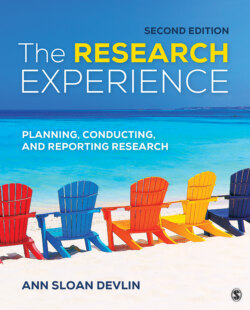Читать книгу The Research Experience - Ann Sloan Devlin - Страница 99
The Discussion Section: Conflicts and Gaps
ОглавлениеLike the introduction, the Discussion provides direction about research possibilities. The Discussion section is shaped like a triangle, starting narrowly (at the top of the triangle), restating whether the hypotheses were supported. Then it broadens to relate the findings of the research to the work cited in the Introduction. The Discussion typically ends with a section on Limitations and Future Directions. If the work is applied, there also may be a specific section called Recommendations or Implications for Practice.
Results: Title of the section in a manuscript where the results are presented; in American Psychological Association (APA) style, the word Results is centered and bolded.
Discussion: Title of section in a manuscript when you interpret the results, centered and bolded in American Psychological Association (APA) style.
The Discussion section provides material to consider for research projects. When authors are relating their work to the existing literature, they talk about their findings being consistent (or not) with this literature. If not, then conflict exists. This conflict provides the opportunity to conduct further research to try to resolve the discrepancies. Limitations are a fruitful area to direct future research because the authors point out the shortcomings of their work; you can try to address these shortcomings, such as better measures or a more heterogeneous population. Returning now to an idea from Michael Shermer (1997) in Chapter 1, overreliance on authorities, don’t be afraid to criticize research that has been published. Beyond the limitations identified by the authors themselves, you may identify other drawbacks to the work; these provide the opportunity for new research projects.
Future Directions also point to research opportunities. Researchers may not be explicit about the directions the research could take, to protect their own “next steps.” At the same time, they may speak in more general terms about possibilities, such as using different age groups or more current measures.
The seventh edition of the APA Publication Manual contains tables that specify standards for reporting Quantitative (Table 3.1), Qualitative (Table 3.2), and Mixed Methods (Table 3.3) research for all sections of a manuscript (Abstract, Introduction, Method, Results, and Discussion). These tables not only provide a roadmap for researchers to make sure they include all of the expected information in their manuscript, but they are also helpful in the planning stages of the research to make sure the necessary steps are taken to obtain the expected information (e.g., types of recruitment, length, and follow-up; transcription processes used for qualitative data).
